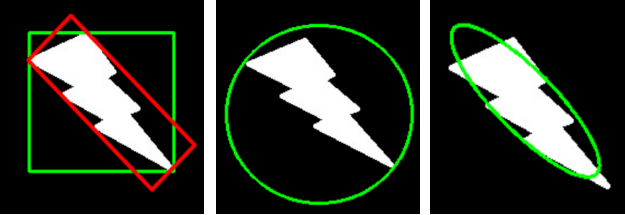一、简介
1、使用特定形状的轮廓包围
在实际应用中, 经常会有将检测到的轮廓用多边形表示出来的需求, 提取包围轮廓的多边形也方便我们做进一步分析, 轮廓包围主要有一下几种: 轮廓外接矩形、轮廓最小外接矩形(旋转)、轮廓最小包围圆形、轮廓拟合椭圆、轮廓逼近多边形曲线

2、轮廓外接矩形 --- boundingRect()
1 CV_EXPORTS_W Rect boundingRect(InputArray points);
points: 输入的二维点集, 可以填Mat类型或std::vector
返回值: Rect类矩形对象
示例:
1 vector<Rect> boundRect(contours.size());//定义外接矩形集合 2 int x0 = 0, y0 = 0, w0 = 0, h0 = 0; 3 for(int i = 0; i < contours.size(); i++) 4 { 5 drawContours(dstImg, contours, i, Scalar(0, 0, 255), 2, 8); 6 boundRect[i] = boundingRect(Mat(contours[i])); 7 x0 = boundRect[i].x; 8 y0 = boundRect[i].y; 9 w0 = boundRect[i].width; 10 h0 = boundRect[i].height; 11 12 rectangle(dstImg, Point(x0, y0), Point(x0 + w0, y0 + h0), Scalar(0, 255, 0), 2, 8); 13 }
二、外接矩形的查找绘制
1 //外接矩形的查找绘制 2 #include "opencv2/opencv.hpp" 3 4 using namespace cv; 5 6 int main() 7 { 8 //外接矩形的查找绘制 9 Mat srcImg =imread("2.jpg"); 10 imshow("src",srcImg); 11 Mat dstImg = srcImg.clone(); //原图备份 12 cvtColor(srcImg, srcImg, CV_BGR2GRAY); //转为灰度图 13 threshold(srcImg, srcImg, 100, 255, CV_THRESH_BINARY); //二值化 14 15 vector<vector<Point>> contours; 16 vector<Vec4i> hierarcy; 17 findContours(srcImg, contours, hierarcy, CV_RETR_EXTERNAL, CHAIN_APPROX_NONE); //查找轮廓 18 vector<Rect> boundRect(contours.size()); //定义外接矩形集合 19 //drawContours(dstImg, contours, -1, Scalar(0, 0, 255), 2, 8); //绘制轮廓 20 int x0=0, y0=0, w0=0, h0=0; 21 for(int i=0; i<contours.size(); i++) 22 { 23 boundRect[i] = boundingRect((Mat)contours[i]); //查找每个轮廓的外接矩形 24 drawContours(dstImg, contours, i, Scalar(0, 0, 255), 2, 8); //绘制轮廓 25 x0 = boundRect[i].x; //获得第i个外接矩形的左上角的x坐标 26 y0 = boundRect[i].y; //获得第i个外接矩形的左上角的y坐标 27 w0 = boundRect[i].width; //获得第i个外接矩形的宽度 28 h0 = boundRect[i].height; //获得第i个外接矩形的高度 29 rectangle(dstImg, Point(x0, y0), Point(x0+w0, y0+h0), Scalar(0, 255, 0), 2, 8); //绘制第i个外接矩形 30 } 31 imshow("boundRect", dstImg); 32 waitKey(0); 33 return 0; 34 }
三、分割硬币轮廓并计数
1 //分割硬币轮廓并计数 2 #include "opencv2/opencv.hpp" 3 #include<iostream> 4 5 using namespace cv; 6 using namespace std; 7 8 int main() 9 { 10 //分割硬币轮廓 11 Mat srcImg =imread("3.png"); 12 imshow("src", srcImg); 13 Mat dstImg = srcImg.clone(); //原图备份 14 cvtColor(srcImg, srcImg, CV_BGR2GRAY); //转为灰度图 15 threshold(srcImg, srcImg, 100, 255, CV_THRESH_BINARY); //二值化 16 Mat element = getStructuringElement(MORPH_RECT, Size(3, 3), Point(-1, -1)); //获得结构元素 17 dilate(srcImg, srcImg, element); //膨胀操作 18 imshow("dilate",srcImg); 19 20 vector<vector<Point>> contours; 21 vector<Vec4i> hierarcy; 22 findContours(srcImg, contours, hierarcy, CV_RETR_EXTERNAL, CHAIN_APPROX_NONE); //查找轮廓 23 vector<Rect> boundRect(contours.size()); //定义外接矩形集合 24 int x0=0, y0=0, w0=0, h0=0,num=0; 25 for(int i=0; i<contours.size(); i++) 26 { 27 boundRect[i] = boundingRect((Mat)contours[i]); //查找每个轮廓的外接矩形 28 drawContours(dstImg, contours, i, Scalar(0, 0, 255), 2, 8); //绘制轮廓 29 x0 = boundRect[i].x; 30 y0 = boundRect[i].y; 31 w0 = boundRect[i].width; 32 h0 = boundRect[i].height; 33 if(w0>30 && h0>30)//筛选 34 { 35 rectangle(dstImg, Point(x0, y0), Point(x0+w0, y0+h0), Scalar(0, 255, 0), 2, 8); //绘制第i个外接矩形 36 num++; 37 } 38 } 39 cout<<"硬币数量:"<<num; 40 imshow("boundRect", dstImg); 41 waitKey(0); 42 return 0; 43 }
四、简单车牌字符分隔
1 //简单车牌字符分割 2 #include "opencv2/opencv.hpp" 3 4 using namespace cv; 5 6 int main() 7 { 8 //---简单车牌字符分隔 9 Mat srcImg =imread("E://Car2.jpg"); 10 Mat dstImg = srcImg.clone(); //原图备份 11 medianBlur(srcImg, srcImg, 5); //中值滤波 12 cvtColor(srcImg, srcImg, CV_BGR2GRAY); //转为灰度图 13 threshold(srcImg, srcImg, 100, 255, CV_THRESH_BINARY); //二值化 14 imshow("threshold", srcImg); 15 imwrite("F://car0.jpg", srcImg); 16 17 vector<vector<Point>> contours; 18 vector<Vec4i> hierarcy; 19 findContours(srcImg, contours, hierarcy, CV_RETR_TREE, CHAIN_APPROX_NONE); //查找所有轮廓 20 vector<Rect> boundRect(contours.size()); //定义外接矩形集合 21 int x0=0, y0=0, w0=0, h0=0; 22 for(int i=0; i<contours.size(); i++) 23 { 24 boundRect[i] = boundingRect((Mat)contours[i]); //查找每个轮廓的外接矩形 25 x0 = boundRect[i].x; 26 y0 = boundRect[i].y; 27 w0 = boundRect[i].width; 28 h0 = boundRect[i].height; 29 if(w0>srcImg.cols/12 && w0<srcImg.cols/5 && h0>srcImg.rows/6 && h0<srcImg.rows*5/6) 30 { 31 char pic_name[10]; 32 sprintf(pic_name, "F:\\%d.bmp", i); 33 Mat ROI = dstImg(Rect(x0, y0, w0, h0)); 34 imwrite(pic_name, ROI); 35 rectangle(dstImg, Point(x0, y0), Point(x0+w0, y0+h0), Scalar(0, 255, 0), 2, 8); //绘制第i个外接矩形 36 } 37 } 38 imshow("boundRect", dstImg); 39 waitKey(0); 40 return 0; 41 }